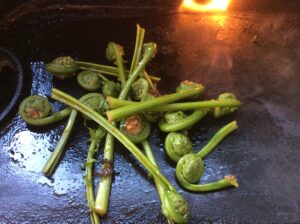Growing just a little of what our families eat can put us back in touch with nature, help foster understanding of where food comes from and realize the real value of what is in our diets. Home production can also help to protect, preserve and create abundance of natural property resources even as they are being used.
In purely monetary terms, does it make sense to grow your own food? Over the past one hundred years households have gone from spending over 40% of their income on groceries to just 14% of wages and that smaller fraction includes more costly processed foods, luxury condiments, snacks and eating out opportunities that did not exist in the past. A dozen eggs in 1919 took about 2 ½ hours of pay to purchase. Think of how many eggs you can buy today by working the same amount of time, dozens of dozens! We would be hard pressed to find a time in history when food has been so cheap and accessible. However, there may be some unseen costs involved in this extraordinary event.
There is increasing knowledge of health impacts, environmental degradation and consequences to agricultural workers in the production of low-cost, plentiful food commodities that we take for granted. One reaction to this awareness is that shoppers are becoming more mindful of what is in their food and where it comes from by purchasing locally. Another result is the seismic resurgence of food production at home because there are measurable and tangible benefits. Finally, producing at home gives you some control over the supply your family needs.
Consumption of wholesome fresh fruit and vegetables are directly related to positive health outcomes. Spending more time outdoors provides immune system support along with stress reduction and interacting with nature activates neuron connections.
You can take advantage of this trend for yourself and test out things that you might desire as part of an edible, sustainable yard.
Here are some thoughts and ideas to get you started;
-

Ostrich fern fiddleheads sauteed on cast iron. The celery shaped stem is an identifying characteristic of this common landscape plant.
Un-Garden: Instead of plowing, tilling, fencing, weeding and cleaning up a large, high-maintenance garden plot, consider using existing resources and unique spaces that you already have for early success. Small niches on your deck, around the yard and in existing landscape beds can provide micro-climates for a variety of edible plants with minimal preparation. Think cool spaces for lettuce and herbs, hot spots for tomatoes and open spaces for vining plants like squash.
- Multiuse Space: A growing area can be created to incorporate other activities. Patios can have locations for edible plants and space to lounge, entertain, cook out and dine. Large planting containers and raised beds are ideal to blend into an outdoor living room for this purpose. Here is a great spot to have fresh herbs right at your fingertips!
- Purposeful Planting: Is your existing landscape tired or overgrown? Consider rejuvenating planting beds with attractive and edible perennial plants. Blueberries produce delicious fruit and provide striking purple leaf color in fall. Rhubarb takes on a tropical plant appearance in landscapes and is one of the earliest fruits in northern climates. You can’t beat grilled asparagus and this easy care plant forms a nice privacy hedge when the picking season is over.
- Wildlife Eating Your Lunch? Fruit producing trees and large shrubs can help where deer are a problem. Trees need complete fencing initially, but once the crown is out of reach only the stem needs protection. Apples, pears, quince, June berry, plum, burr oak (for edible acorns), hazelnut and others compliment your landscape and provide habitat for beneficial birds and insects.
- Discover Foraging: You may already have food plants on your property that you didn’t know about. There are some excellent foraging books to learn more (you should not eat plants that you don’t know!). Daylily blossoms and buds are eaten by many cultures, ostrich fern fiddleheads are a delicacy and some weeds like purslane make tasty salad.
- Start Small: Build confidence as you cultivate. Small pots on the window sill, a balcony planter or containers on the deck work great to give things a try. You can start small seeds for lettuce and herbs indoors and then divide them for outdoor planting. *Remember plants started indoors get sunburn just like people after a long winter. Ease stress on new plants by providing them with shade for their first few days outside.
We are at a place in time where home is a refuge and sanctuary. Growing a few things adds to the comfortable feeling of security and shelter. But don’t forget it can be a lot of fun too discovering what you can produce on your own and transform into an enticing part of your lifestyle. Now that is food for thought!
